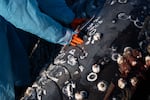
Despite extended efforts to save a whale beached at San Marine State Park near Yachats earlier this month, the animal was euthanized. Its death brought together local residents, scientists and tribal members who say they’re drawing lessons – and hope – from the loss.
Saskia Hatvany / OPB
Editor’s note: This story contains photos and a video depicting the necropsy and disassembly of a deceased whale, which some people might find disturbing.
When a humpback whale beached itself on the Oregon Coast earlier this month, thousands of people followed along through the attempt to save it — and mourned the animal when the rescue effort ultimately failed.
But as the whale was euthanized, and in the days that followed, its death also brought together local residents, scientists and tribal members who say they’re drawing lessons — and hope — from the loss.
Jim Rice, program manager of the Oregon Marine Mammal Stranding Network, choreographed a somber dance as veterinary students worked alongside state park staff and tribal members to conduct a necropsy and disassemble the whale.
Living whales almost never wash up on the Oregon Coast, Rice said. He could only think of one other time a living humpback washed up in the past 20 years. And when deceased whales wash up, they’ve usually been dead for a while.
“A freshly dead whale presents us with a rare opportunity to gather fresh tissues that can inform us a lot of information about the animal’s health status prior to its death,” Rice said, “and about the overall biology of the whale itself, of the humpback whale in this case.”

Veterinary students from Oregon State University and professionals from the Oregon Veterinary Diagnostic Laboratory at OSU perform a necropsy on a beached whale near Yachats, Ore., on Nov. 18, 2025. Left to right: Kaitlyn Oliver, Makenna Bailey, Cruzado Diaz, Caitlin Gaffney and Dr. Rachel Fost.
Saskia Hatvany / OPB
That’s one reason fourth-year veterinary students from Oregon State University were invited to assist, under the supervision OSU’s Oregon Veterinary Diagnostic Laboratory. They may never have another lesson like this. The marine mammal was 28 feet long and weighed 8 to 10 tons. But Rice estimates it was only 1 to 2 years old — developmentally like a human in preschool, or maybe elementary school, he said.
Vet students helped to collect samples for future testing by the state veterinary lab. The students examined its baleen, the hair-like sieve in the whale’s mouth that it used to filter food in place of teeth. And they worked alongside members of the Confederated Tribes of Siletz Indians to collect artifacts for the tribe.
Studying the whale was a rare opportunity for scientists and students. And collecting those artifacts and praying for the workers and the whale were rare opportunities for the tribal members, according to Lisa Norton, chief administrative officer with the Siletz Tribes.
“It is such an honor and such a blessing that we have been out here to bear witness,” Norton said. “But also that we’re able to bring these traditions back, even as we’re learning them.”
The tribes that make up the Siletz originated from a big stretch of the West Coast — from California to Washington, inland and along the water. Some tribal ancestors had connections to whales and the ocean — traditions that were severed when they were forcibly relocated by settlers. Working alongside scientists and collecting artifacts from the whale created an opportunity to reconnect with that severed past.
“We will use every piece of the whale that we take home with us,” Norton said. “Traditionally, the vertebrae from a large enough whale would be stools. Rib bones, smaller ones, would be used as clubs. The baleen would be used like regalia.”
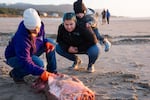
From left, Kaylee Myers, Justyne Oleman and Nova Ware of the Siletz Tribe search for bones in the flesh of the whale. Members of the Confederated Tribes of Siletz Indians helped disassemble the whale and collected samples for cultural use.
Saskia Hatvany / OPB
Disassembling the whale, essentially butchering it, was a multi-generational effort for the Siletz. Norton’s adult son helped to gather bones and blubber. Younger tribal members, including a few toddlers, watched the older generations
“I mean look at that, that little one. They’re not afraid,” Norton said as a small child smiled at the working adults. “That’s the piece that I want people to see.”
As children observed and tribal members worked to disassemble the whale, Nate Wilson watched from a distance.
Wilson lives near the coast and likes to film whales and sea lions for TikTok. And when word first spread of a beached humpback, he was one of dozens of people who felt drawn to do more — to try to save it.
He now realizes it was a dangerous effort that put would-be rescuers at risk. He recounted the experience of one woman, not much more than 5 feet tall, who tried to help.
“As she got up next to the whale, a wave came in. It was probably a 3-foot-tall wave,” he said. “There was so much force, it sucked her down underneath the side of the whale. The other people there trying to help had to help rescue her.”

People gather around a beached whale at San Marine State Park.
Saskia Hatvany / OPB
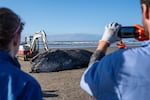
People watch as workers flip over the beached whale.
Saskia Hatvany / OPB
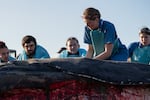
People collect samples and perform a necropsy on the whale to learn more about the condition of the whale before it died.
Saskia Hatvany / OPB

Blubber is collected from the whale.
Saskia Hatvany / OPB
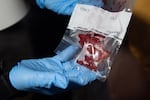
A piece of the heart is collected from the whale.
Saskia Hatvany / OPB

Pedestrians watch from a distance as the whale is disassembled.
Saskia Hatvany / OPB
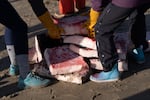
Blubber is collected for the Confederated Tribes of Siletz Indians.
Saskia Hatvany / OPB
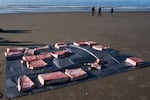
Blubber lies on the beach.
Saskia Hatvany / OPB
Wilson said watching the work to remove the whale at low tide made it clear that the rescue effort had been doomed from the start. The whale was lodged three feet deep in the sand, which was not clear when people were trying to return it to the sea.
“There’s nothing we could have done,” he said. “It’s just too big of an animal.”
Rice agrees. During low tide it would have been impossible to safely move the nearly 10-ton whale to the ocean, he said. During high tide, moving it was also dangerous, and waves offshore were so strong they would have battered the weakened animal.
Ultimately, veterinarians from the West Coast Marine Mammal Stranding Network euthanized the whale to end its suffering.
“We’re all very sad,” said Norton with the Siletz tribe. “We consider our relationship with nature and our relationship with each other very sacred.”
She didn’t know the scientists or veterinary students who helped tribal members disassemble the whale until they all met on a beach north of Yachats.
“They’ve been so willing to help and we’ve been able to kind of complement each other to achieve this beautiful goal of making sure that this whale’s life isn’t in vain.”

